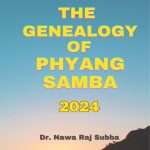Genealogy of Phyang Samba 2024

Copyrights © 2024 Nawa Raj Subba.
Inside Book
The Kirat Rai Limbu community actively shapes their cultural identities through their traditional customs of marriage, birth, and funeral rites. ‘Nam’ in the Limbu language is ‘Gham’ in Khas Nepali. Using the sun and treating him as a god is a cultural tradition as a witness to significant family events.
The researcher has employed an anthropological approach to present data, re-evaluating and elucidating overlooked parts of historical and contemporary ontology from the perspectives of axiology and epistemology.
History and genealogy include oral information. Reading the Mundhum takes you to the Manggena Yak and beyond, where all men’s last names come from and where people came from. Mundhum connects Kirats to their heritage and pride. Comprehending history is necessary for understanding the present and future. Genealogy shapes culture and continuity. This behavioral pattern predicts ancestry. Anthropology now sees family beyond fathers and children. It must also be able to give reasons, events, and times in response. After all, genealogy is a collection of family trees and a fact- and evidence-based narrative about the past. This genealogy writing analyzed pertinent evidence to establish an updated genealogy of the Phyang Samba ethnicity as a representative of the Nepali nation.
Genealogy is not merely a collection of lists of family members in different regions or a set of generations. Since genealogy is an anthropological tool, it is also a reliable source of ethnic history and knowledge. It answers some important questions and decodes them in a factual manner. Genealogy not only connects family members; it also connects any ethnic history and identity living in and outside the country to the country’s history.
